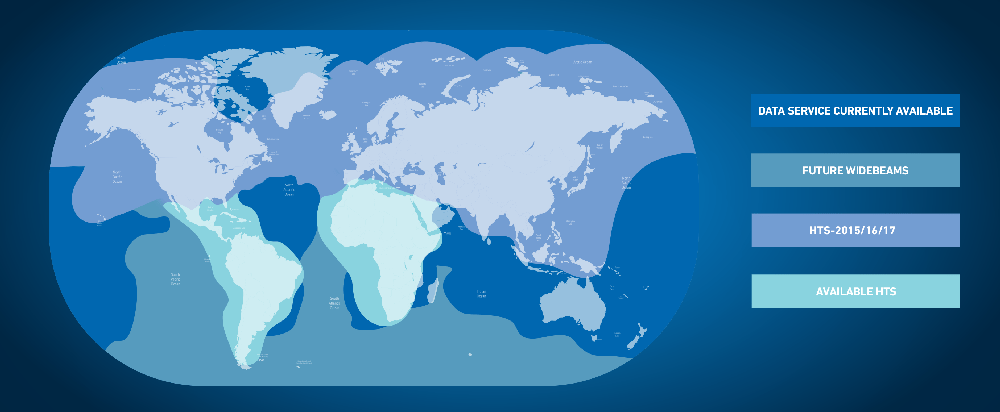Latest News
[Via Satellite 02-10-2015] If all goes as planned, by 2017 Panasonic Avionics will have High Throughput Satellite (HTS) capacity that wraps around the world for its In-Flight Connectivity (IFC) services. The company has been buying up HTS capacity at a feverish rate, serving as an anchor customer for two of Intelsat’s first EpicNG satellites, Intelsat 29e and Intelsat 33e, along with Eutelsat’s triple-mission Eutelsat 172b satellite. Intelsat 29e is slated to launch later this year, followed by Intelsat 33e in 2016, and Eutelsat 172b the year after. But that is not the end of Panasonic’s HTS ambitions.
David Bruner, VP of global communications at Panasonic Avionics, told Via Satellite the company experienced a lull in 2014 as the Federal Aviation Association (FAA) looked for solutions to bird-strikes on radomes, but airlines are spooled up and cranking out installations again. New customers including Air Berlin, Aeromexico, and China Eastern are starting installations, and the company anticipates three or four more new customers coming online between now and March. These and existing customers are fueling the need for even more capacity.
“We’ve already committed to a lot of HTS purchases,” said Bruner. “We’re in the middle of procuring massive additional satellite capacity, and you want to know that the customers are coming along with you. So seeing this adoption and the commitments of aircraft is really important to us to make sure the business is heading in the right direction, and that is the case.”
With IS-29e, IS-33e and Eutelsat 172b, Panasonic Avionics will have HTS capacity that covers the world’s high-density air traffic routes. The company already blankets more than 99 percent of the world with satellite and, according to Bruner, 80 percent of all airline flight hours will soon be covered by HTS. The company’s three-pronged strategy, he said, has been to get all the regulatory approvals needed for worldwide coverage, then add global coverage and layer it with even more capacity in highly trafficked regions as needed. This means more HTS capacity within existing footprints.
“It’s really what we call ‘extreme HTS,’” Bruner explained. “It’s the same philosophy — you just have smaller spot beams and much more frequency in those beams … but you only do this in areas where there is very high-density air traffic. You need lots of airplanes operating in a particular geographic region. North America is one of those regions that can justify this additional investment.”
In North America, Panasonic Avionics currently provides IFC through six transponders that essentially cover the same geography. Bruner said the transition to high-throughput capacity enables the company to put everyone on the same network, streamlining the provision of broadband services with greater efficiency.
Panasonic Avionics is also developing a new lightweight electronically steered phased array antenna through a partnership with Boeing. Bruner said the small size of the antenna is anticipated to find a niche with regional jets and business jets, opening up markets that were not always favorable to satellite in the past. He added the new antenna — now slated for release in 2017 — will work best with satellites that have a high Effective Isotropic Radiated Power (EIRP) performance and can deliver lots of bandwidth.
Outside of North America, where many airlines have already committed to an IFC provider, Bruner said Panasonic Avionics is seeing new activity in places such as South America and Oceania, which are starting to experience the growth found in Europe two to three years ago. Connected aircraft flying from places such as North America, Europe and the Middle East are spurring on airlines in some of these areas that have been last to move forward with IFC broadband services. As areas with dense air traffic pursue IFC, they become prime candidates for HTS.
“We are basically doing that worldwide — and we are not stopping. Right now we are working on additional procurements because within those areas are smaller geographies with extremely dense air traffic. We are going for even more capacity, because each airplane and user is using more capacity this year than they did last year,” he said.
Bruner said airlines in South America have not yet begun implementation activity, but that they are starting to take interest. Brazil, which will be covered by IS-29e, is expected to be a top area, along with flight paths such as Buenos Aires in Argentina to Rio de Janeiro, Brazil. Panasonic Avionics anticipates similar growth in Australia and Oceania. The geography is slightly more difficult, Bruner said, but provides a strong opportunity for satellite. As more both domestic and international airlines equip their fleets, Panasonic Avionics will look to bring HTS capacity to win over customers in popular airspace.
Get the latest Via Satellite news!
Subscribe Now
